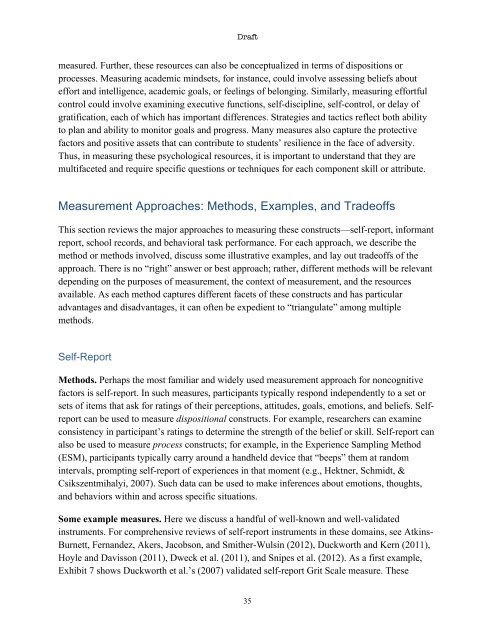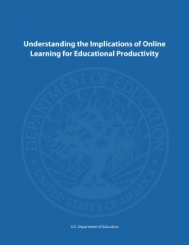Promoting Grit, Tenacity, and Perseverance - U.S. Department of ...
Promoting Grit, Tenacity, and Perseverance - U.S. Department of ...
Promoting Grit, Tenacity, and Perseverance - U.S. Department of ...
You also want an ePaper? Increase the reach of your titles
YUMPU automatically turns print PDFs into web optimized ePapers that Google loves.
Draft<br />
measured. Further, these resources can also be conceptualized in terms <strong>of</strong> dispositions or<br />
processes. Measuring academic mindsets, for instance, could involve assessing beliefs about<br />
effort <strong>and</strong> intelligence, academic goals, or feelings <strong>of</strong> belonging. Similarly, measuring effortful<br />
control could involve examining executive functions, self-discipline, self-control, or delay <strong>of</strong><br />
gratification, each <strong>of</strong> which has important differences. Strategies <strong>and</strong> tactics reflect both ability<br />
to plan <strong>and</strong> ability to monitor goals <strong>and</strong> progress. Many measures also capture the protective<br />
factors <strong>and</strong> positive assets that can contribute to students’ resilience in the face <strong>of</strong> adversity.<br />
Thus, in measuring these psychological resources, it is important to underst<strong>and</strong> that they are<br />
multifaceted <strong>and</strong> require specific questions or techniques for each component skill or attribute.<br />
Measurement Approaches: Methods, Examples, <strong>and</strong> Trade<strong>of</strong>fs<br />
This section reviews the major approaches to measuring these constructs—self-report, informant<br />
report, school records, <strong>and</strong> behavioral task performance. For each approach, we describe the<br />
method or methods involved, discuss some illustrative examples, <strong>and</strong> lay out trade<strong>of</strong>fs <strong>of</strong> the<br />
approach. There is no “right” answer or best approach; rather, different methods will be relevant<br />
depending on the purposes <strong>of</strong> measurement, the context <strong>of</strong> measurement, <strong>and</strong> the resources<br />
available. As each method captures different facets <strong>of</strong> these constructs <strong>and</strong> has particular<br />
advantages <strong>and</strong> disadvantages, it can <strong>of</strong>ten be expedient to “triangulate” among multiple<br />
methods.<br />
Self-Report<br />
Methods. Perhaps the most familiar <strong>and</strong> widely used measurement approach for noncognitive<br />
factors is self-report. In such measures, participants typically respond independently to a set or<br />
sets <strong>of</strong> items that ask for ratings <strong>of</strong> their perceptions, attitudes, goals, emotions, <strong>and</strong> beliefs. Selfreport<br />
can be used to measure dispositional constructs. For example, researchers can examine<br />
consistency in participant’s ratings to determine the strength <strong>of</strong> the belief or skill. Self-report can<br />
also be used to measure process constructs; for example, in the Experience Sampling Method<br />
(ESM), participants typically carry around a h<strong>and</strong>held device that “beeps” them at r<strong>and</strong>om<br />
intervals, prompting self-report <strong>of</strong> experiences in that moment (e.g., Hektner, Schmidt, &<br />
Csikszentmihalyi, 2007). Such data can be used to make inferences about emotions, thoughts,<br />
<strong>and</strong> behaviors within <strong>and</strong> across specific situations.<br />
Some example measures. Here we discuss a h<strong>and</strong>ful <strong>of</strong> well-known <strong>and</strong> well-validated<br />
instruments. For comprehensive reviews <strong>of</strong> self-report instruments in these domains, see Atkins-<br />
Burnett, Fern<strong>and</strong>ez, Akers, Jacobson, <strong>and</strong> Smither-Wulsin (2012), Duckworth <strong>and</strong> Kern (2011),<br />
Hoyle <strong>and</strong> Davisson (2011), Dweck et al. (2011), <strong>and</strong> Snipes et al. (2012). As a first example,<br />
Exhibit 7 shows Duckworth et al.’s (2007) validated self-report <strong>Grit</strong> Scale measure. These<br />
35
















